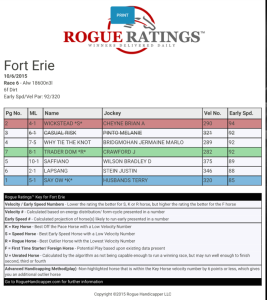In this post I will help the new fan and novice horseplayer understand what the Velocity Number(Vel#) means and how to have confidence to use the Rogue Ratings App to get You to the cashier window!
The velocity number in the Rogue Ratings App is a complete calculation of a horses running potential in a race. It is based on time tested factors which are known and other factors which are not known to all horseplayers that helps to correctly determines why a horse does and does not run well in a race. These range from but are not limited to; form cycle projections, race scenarios calculations, speed calculations and additional hidden turf factors. Now, the lower the velocity number for a horse the better it looks to potentially perform well in a race and also when you compare it to the other horses in a race.
All of this information crunched into a simple number gives you a complete overall understanding of how a horse looks to potentially perform in a particular race!
It’s also very important to understand that ‘racing luck’ is a powerful factor that can and does influence the outcome of races, and is why horse don’t always run like a clock(horses are animals) and the best we can ask for is a correct and honest assessment of a horse or horses realistic potential to perform in a race.
The beauty of the Rogue Ratings App for the new fan or novice handicapper is that it allow you to immediately win at this game as you are learning it “Right out of the Gate”. The computer program does this by highlighting in colors and symbols the horses it recommends to potentially play. It’s really that simple!…and I will see you at the cashier window!






Follow RogueHandicapper